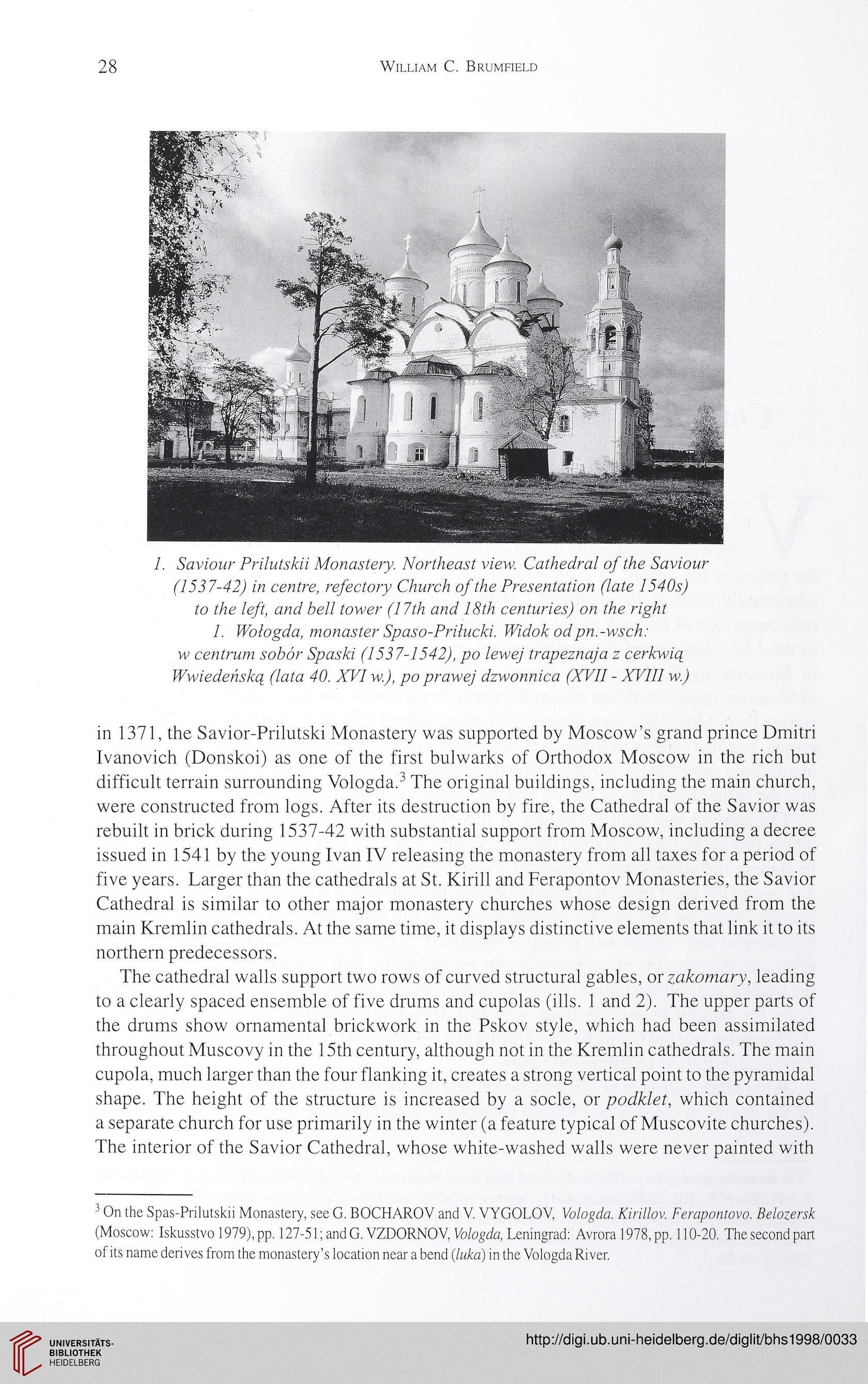28
William C. Brumfield
1. Saviour Prilutskii Monastery. Northeast view. Cathedral of the Saviour
(1537-42) in centre, refectory Church of the Presentation (late 1540s)
to the left, and beli tower (17th and 18th centuries) on the right
1. Wołogda, monaster Spaso-Priłucki. Widok odpn.-wsch:
w centrum sobór Spaski (1537-1542), po lewej trapeznaja z cerkwią
Wwiedeńską (lata 40. XVI w.), po prawej dzwonnica (XVII - XVIII w.)
in 1371, the Savior-Prilutski Monastery was supported by Moscow’s grand prince Dmitri
Ivanovich (Donskoi) as one of the first bulwarks of Orthodox Moscow in the rich but
difficult terrain surrounding Vologda.3 The original buildings, including the main church,
were constructed from logs. After its destruction by fire, the Cathedral of the Savior was
rebuilt in brick during 1537-42 with substantial support from Moscow, including a decree
issued in 1541 by the young Ivan IV releasing the monastery from all taxes for a period of
five years. Larger than the cathedrals at St. Kirill and Ferapontov Monasteries, the Savior
Cathedral is similar to other major monastery churches whose design derived from the
main Kremlin cathedrals. At the same time, it displays distinctive elements that link it to its
northern predecessors.
The cathedral walls support two rows of curved structural gables, or zakamary, leading
to a clearly spaced ensemble of five drums and cupolas (ills. 1 and 2). The upper parts of
the drums show ornamental brickwork in the Pskov style, which had been assimilated
throughout Muscovy in the 15th century, although not in the Kremlin cathedrals. The main
cupola, much larger than the four flanking it, creates a strong vertical point to the pyramidal
shape. The height of the structure is increased by a socle, or podklei, which contained
a separate church for use primarily in the winter (a feature typical of Muscovite churches).
The interior of the Savior Cathedral, whose white-washed walls were never painted with
3 On the Spas-Prilutskii Monastery, see G. BOCHAROV and V. VYGOLOV, Yologda. Kirillov. Ferapontovo. Belozersk
(Moscow: Iskusstvo 1979), pp. 127-51; and G. VZDORNOV, Yologda, Leningrad: Avrora 1978, pp. 110-20. The second part
of its name deri ves from the monastery’s location near a bend (juka) in the Yologda River.
William C. Brumfield
1. Saviour Prilutskii Monastery. Northeast view. Cathedral of the Saviour
(1537-42) in centre, refectory Church of the Presentation (late 1540s)
to the left, and beli tower (17th and 18th centuries) on the right
1. Wołogda, monaster Spaso-Priłucki. Widok odpn.-wsch:
w centrum sobór Spaski (1537-1542), po lewej trapeznaja z cerkwią
Wwiedeńską (lata 40. XVI w.), po prawej dzwonnica (XVII - XVIII w.)
in 1371, the Savior-Prilutski Monastery was supported by Moscow’s grand prince Dmitri
Ivanovich (Donskoi) as one of the first bulwarks of Orthodox Moscow in the rich but
difficult terrain surrounding Vologda.3 The original buildings, including the main church,
were constructed from logs. After its destruction by fire, the Cathedral of the Savior was
rebuilt in brick during 1537-42 with substantial support from Moscow, including a decree
issued in 1541 by the young Ivan IV releasing the monastery from all taxes for a period of
five years. Larger than the cathedrals at St. Kirill and Ferapontov Monasteries, the Savior
Cathedral is similar to other major monastery churches whose design derived from the
main Kremlin cathedrals. At the same time, it displays distinctive elements that link it to its
northern predecessors.
The cathedral walls support two rows of curved structural gables, or zakamary, leading
to a clearly spaced ensemble of five drums and cupolas (ills. 1 and 2). The upper parts of
the drums show ornamental brickwork in the Pskov style, which had been assimilated
throughout Muscovy in the 15th century, although not in the Kremlin cathedrals. The main
cupola, much larger than the four flanking it, creates a strong vertical point to the pyramidal
shape. The height of the structure is increased by a socle, or podklei, which contained
a separate church for use primarily in the winter (a feature typical of Muscovite churches).
The interior of the Savior Cathedral, whose white-washed walls were never painted with
3 On the Spas-Prilutskii Monastery, see G. BOCHAROV and V. VYGOLOV, Yologda. Kirillov. Ferapontovo. Belozersk
(Moscow: Iskusstvo 1979), pp. 127-51; and G. VZDORNOV, Yologda, Leningrad: Avrora 1978, pp. 110-20. The second part
of its name deri ves from the monastery’s location near a bend (juka) in the Yologda River.




